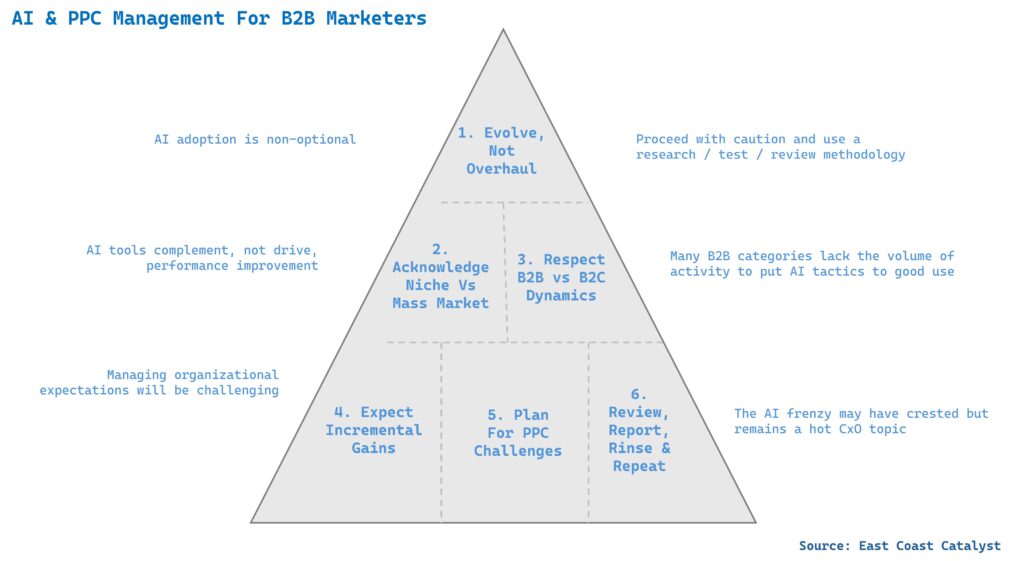AI & PPC Management
Six factors for B2B marketers to consider while incorporating AI into their PPC plans.

NEED TO KNOW
- Google processes 15 billion searches per day to ChatGPT’s 40 million
- AI engines are mostly impacting top-of-funnel for B2B advertisers
- CTRs have fallen by 30% for some B2B keyword categories
- B2B PPC programs need to evolve for AI but rip-and-replace is unnecessary
- AI overviews make B2B PPC execution more difficult
Here are six factors for B2B marketers to consider when formulating AI and PPC strategies.

- EVOLVE, NOT OVERHAUL. While some early stage B2B companies can use AI tactics as a foundational element of operations and the approach will help to accelerate their development, the correct overall approach for most B2B marketing teams to AI will be a gradual one, and this applies to PPC management as well. In addition to using the embedded AI capabilities of the PPC platforms — both Google Ads and Microsoft/Bing Ads use AI extensively — a crop of standalone tools have emerged in recent years that can play a meaningful role in day-to-day operations, primarily in the areas of content creation, competitor research, and analysis/insights.
Teams managing more than ~$2M/year in PPC budget — or more than ~$150,000 / month – have unique challenges when it comes to optimization strategies, and this applies to AI as well. Generally speaking, the larger the budget, the more an operation will be impacted by automation tactics such as AI.
Pro Tip: The PPC management category is robust, with new tools being introduced regularly. Continue to stick with what’s worked historically — performance and outcomes are the only thing that matter, not how they were achieved — and test new tactics regularly but not to the point where it becomes a distraction. - ACKNOWLEDGE NICHE vs MASS MARKET. We know that AI is impacting B2B marketers in two primary ways: how we do our jobs, and how we reach our target audiences. On the second point, it’s not as much of a short term priority, since early adopters of AI tools like ChatGPT, Gemini and Perplexity are a niche market. They tend to be educated, male and young (under 30) – not a high priority B2B target demographic, but also not one we can afford to ignore, either.
We know from studying B2B buying journeys that the path is usually non-linear, multifaceted, and unpredictable — which is why the B2B marketing category as a whole has embraced a 24/7/365 philosophy. We need to be everywhere target audience eyeballs exist, all the time. And delivering ads and content that appeal to CxOs and senior managers and compel action — like signing up for a newsletter or requesting a demo or scheduling a sales call.
Though professionals with just a few years of experience — the majority of current ChatGPT users — rarely drive B2B buying decisions, they can play a role, like being tasked with creating vendor short lists, and that’s the main reason why B2B marketers need to accommodate AI searches, either via paid or organic tactics, or both. (Paid: to get placement above the AI Overviews. Organic: to try to get those high profile SERP placements.) It’s not a high priority directive in B2B — yet — but should be worked into ongoing optimization plans.
Pro Tip: Pick a handful of relevant keyword strings to target for AI optimization, create AI-friendly content, and promote them using PPC tactics. This approach can help to jumpstart AI overview performance and, when successfully, are nice vanity metrics to report on. - RESPECT B2B vs B2C DYNAMICS. For all the talk about the many attractive features of digital marketing — mainly oriented around targeting and tracking — the one irrefutable law of marketing is volume matters. Only 5% of companies are ever actively “shopping” for our B2B solutions, so B2B marketers already up against challenging odds, and this reality is borne out in the relatively small keyword inventories that we pursue — especially in low- to mid-funnel, where targets are closer to making a purchase.
Consider the mainstream, B2C, mass market case of Nike Air Force 1 sneakers, a powerhouse in the shoe company’s lineup, selling more than 10 million pairs every year. There are more than 100,000 searches every month for the shoes, with Nike, Dick’s Sporting Goods, Foot Locker and others competing for clicks, both via paid and organic search engine marketing methods.
By contrast, a fairly common B2B shopping search term is “business cleaning services”, which register ~1,000 searches per month. Keyword inventories of fewer than 1,000 or even 100 monthly searches are common in B2B PPC programs and require tailored optimization strategies due to the lack of overall activity, subsequent lack of signal data, and increasing competition from new entrants to the B2B PPC arena, which is forecast to triple in size between 2019 and 2026. So B2B advertisers need to make do with less data to inform decision making, while also accounting for weeks- months- or even yearslong buyer journeys that sometimes involve as many as a dozen people getting information from various online and offline sources. This relative lack of structure, as compared to the B2C environment, makes automation opportunities fewer and farther between.
Takeaways: Many of the AI tactics getting socialized in mainstream media business coverage are far more applicable to B2C than B2B situations due to the relatively low levels of online activity in most B2B categories. - EXPECT INCREMENTAL GAINS. B2B marketers can realistically expect to make 5%-25% efficiency gains in their PPC management operations by embracing AI tools. In the short term, this will most likely be realized in the form of fewer staff, as evidenced in part by the reshaping that’s underway in the (B2C-centric) advertising agency arena. In-house paid media teams are relying less on contractors and taking on more complementary tasks in the campaign supply chain, like trafficking, ad unit creation, analysis, and reporting.
Performance gains will be more difficult to identify. Because digital advertisers are constantly on the lookout for even the most arcane new tactic that could help — a new keyword cluster, ad unit copy format, or attribution tool — it will be a challenge to isolate the introduction of a new tool into the stack. (This is especially true if it’s redundant with whatever new and free AI feature that’s been added to Google Ads or SEMRush in recent months.)
Takeaways: Expectations for gains facilitated by AI, especially in marketing, are at an all-time high as of the summer of 2025; managing AI expectations will be a critical skill for B2B paid media professionals — and, indeed, all B2B marketers through 2026.
- PLAN FOR PPC CHALLENGES. 2025 has been an almost universally challenging year for the B2B category due to economic uncertainty and that’s certainly been evident in B2B PPC. Keyword inventory has been mostly healthy but ROI on inbound leads is taking longer to realize due to extended sales cycles while at the same time competition is increasing because more companies are rolling out new PPC programs. This means prices are rising while performance is decreasing.
In parallel, a disruptive new technology in the form of AI is both cluttering up the top of SERPs with AI Overviews and Copilot Answers, and also providing a search-like alternative solution that circumvents the search engines almost entirely. According to Bain, these are causing click through rates to decline by as much as 30% in some B2B sectors such as enterprise software.
Do these two forces have a generally negative effect on the overall B2B PPC environment? Yes, they do. Less traffic and more noise are generally bad for Google Ads and Microsoft/Bing Ads. But it also increases the relative importance of the more limited real estate for ads and fewer users to serve them up to. This has the perverse effect of making the placements more important to advertisers, especially ones that are unable to get favorable organic performance in targeted keyword clusters. Best practice companies perform well on both the paid and organic fronts, but paid performance has historically been easier to scale reliably. That just became more difficult.
Takeaway: PPC can still deliver positive ROI for most B2B companies, in our experience, and by as much as 5X in some cases. But AI is making it more difficult to manage successful B2B PPC programs. - REVIEW, REPORT, RINSE & REPEAT. Developing and maintaining an effective reporting system can be as difficult as creating and managing an ROI-positive B2B PPC advertising program. Everyone has unique expectations for what B2B PPC can deliver based on their media diets, are often skeptical about the veracity of marketing data (with good reason, since we can only track about 50% of activity with precision), and also might have conflicting motivations about what they want from the data (the age-old tension between marketing and sales persists).
B2B marketers are well-served to understand the environment and adjust accordingly. A general approach that works for most B2Bs includes regular and frequent summary reports — monthly and quarterly cadences suffice — along with dashboards that can be accessed 24/7. Narrative is also critical, and AI needs to be weaved into both the qualitative and quantitative reporting — which tools are being tested and why, how they are performing, and whether they will become part of the marketing stack over the long-term or be discarded.
Pro Tip: Ignore or deemphasize regular reporting at your own risk. While the overall fever pitch associated with AI may have crested, it’s going to remain a hot topic for the foreseeable future and B2B marketers can either take ownership of defining their AI strategies or allow someone else in the organization to do it for them.
RESOURCES & FURTHER READING
- B2B Digital Marketing Case Studies
- Hiring A Freelance PPC Consultant
- Does PPC Work For B2B?
- B2B Lead Generation Ideas
############################################
Tim Bourgeois is a freelance PPC consultant at East Coast Catalyst and manages the PPC management services practice. Contact him at tbourgeois(a)eastcoastcatalyst.com to discuss how his team can help with B2B digital marketing strategy and lead generation initiatives.
